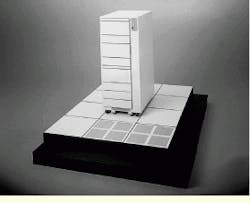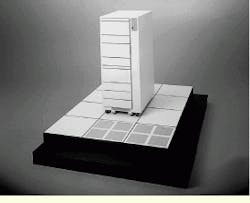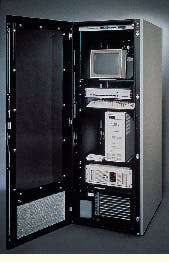You may need a different power-protection strategy--either a one-on-one approach, a clustered system, integrated protection, or floor-by-floor protection facility-wide--depending on the type of facility and kind of network.
Tom Pfendler, Liebert Corp.
Power protection used to be as simple as placing all sensitive equipment inside a "glass house" that was connected to a single power-protection source, such as an uninterruptible power supply (UPS). Today, with computers migrating from the raised-floor data center into telecommunications closets and even open work areas, power-protection strategies must deal with a much more complicated situation.
First, power-protection equipment must contend with an increasingly wide range of system configurations. Servers, workstations, routers, hubs, bridges and other sensitive components must all be taken into consideration.
Second, as computer-based systems become more integral to telecommunications operations, even a minor power problem can have catastrophic effects--from absorbing a half day of an employee`s time for reentering data to sustaining a costly production loss because an industrial machine controller`s part program was erased by a power glitch and the machine produced scrap. In many telecommunications applications (e.g., computerized order processing) a power problem can completely shut down operations.
To serve a user`s needs, the UPS, which is the main component in most power-protection systems, must be able to handle different types of power inputs, including imperfect power from the electric utility, direct current (DC) power from batteries, the variable output of standby generators, surges and sags from inside the building, and even harmonics from within the computer network. Contemporary UPS systems are available in a variety of configurations to meet these multiple needs, but they can generally be classified into one of three types of technologies: online, offline or line interactive.
An online UPS uses a device called an inverter to deliver computer-grade power under all operating conditions. At the same time, the UPS continually recharges its battery. Since a battery produces DC power, the inverter in the UPS functions to convert DC to the alternating-current (AC) output needed by the electronic equipment. Since the inverter operates continuously, the network manager can be assured that the UPS is working properly and is ready to respond instantaneously to a power emergency.
The inverter/converter in an offline UPS system is, as the name implies, "off." If an outage occurs, a small amount of time is needed while the UPS inverter switches to battery mode. The main drawback of offline UPSs is that the time needed to switch from AC to battery power may present a problem for some computers.
A line-interactive UPS takes a hybrid approach that borrows from both online and offline technologies. The inverter in a line-interactive UPS performs a dual function. During normal operation, it filters the line current to the load; at the same time, it provides power that keeps the battery fully charged. When power fails, the inverter reverses operation, converting the battery`s DC output to AC power. At the same time the transfer switch of the UPS shifts from utility to battery output. Since the inverter in a line-interactive UPS is constantly running, the DC/AC changeover mode is slightly more reliable than that of offline units.
Differing UPS technologies are not the only variable in the power-protection picture. There are also four basic types of power-protection solutions. Each type of solution is appropriate for some network configurations and wrong for others. Large networks may even require a combination of types. The best solution in a particular situation is the one that most closely matches user needs, based on criteria such as load size, application criticality, the proximity of protected equipment, and the nature of the power problems.
One-on-one approach--Having grown out of the early phases of distributed computing, this strategy is a relatively common configuration for many small networks. Available products cover a wide range, including standby designs, line-interactive technology that actually conditions power, and true online technology that offers extended "ride-through" time because of its battery.
However, the cost of one-on-one protection can become a negative factor as the network grows. Adding UPSs, battery replacements and related functionality, such as communications, can be expensive down the road. For example, the cost difference between investing in protection of peripheral equipment, such as printers, found at each workstation versus strategically placing one or more powerful pieces of equipment to service multiple nodes on the network can be substantial. With one-on-one protection, floor space for protective devices is also required at each computer terminal or workstation.
The situations in which one-on-one protection may be the best solution include:
- Single users connected to the network by a modem or a power-isolated telecommunications switch
- Individual, isolated nodes where the application is sufficiently important to warrant at least minimal protection
- Peripheral equipment, such as plotters, workgroup printers, or network output devices, where unexpected shutdowns can inconvenience a large group of users.
Other benefits of the one-on-one strategy are that the small units are inexpensive and can be purchased at almost any computer store, from a catalog, or through a local value-added reseller; the units are easy to install and light enough to be hand-carried without special configuration or wiring; the controls are easy to use; and the network configuration is simple--add a UPS for each new piece of equipment.
Clustered systems--This type of protection permits network nodes located near one another to be protected by one UPS. It is a configuration that works well with small but growing networks where at least some nodes are clustered together; examples include collocated file servers, hubs, routers and bridges, as well as workstations or personal computers within a department or office. If the equipment is within a few feet of the server or hub, a single large UPS can protect the entire cluster.
The clustered approach may actually offer less-expensive protection per node than the one-on-one strategy. It also allows network managers the luxury of assigning protection priorities via a combination of UPSs and simple network management protocol (Snmp) communications tools. Snmp is a de facto software communication protocol that defines how all devices on a network are managed; it is vendor- and platform-independent.
This level of protection also offers superior reliability, testing and service when compared to the one-on-one strategy. Fewer battery strings and less battery-management software simplify testing and service, while a built-in maintenance bypass allows the UPS to be serviced without disruption of the critical load. The static bypass improves reliability by automatically transferring the critical load to utility power in the event of a UPS malfunction. And yet, clustered-system products do require more planning, and their physical installation can be more complicated.
The situations in which clustered protection works best include:
- Small but growing networks or multiple servers and support equipment in one area
- Network clusters where mission-critical applications are routinely run
- Network clusters with access to high-speed communications
- Networks where nodes--or entire clusters--are routinely moved from one location to another.
Other benefits of clustered systems are that, depending on the number of nodes served, a single, large UPS is often less expensive per node protected than with the one-on-one approach, because the clustered approach utilizes more of the UPS`s capacity; there are UPSs that have more sophisticated technology and features than those available with the one-on-one approach and larger, full-featured UPSs that are communications-ready or have communications capability already installed.
Integrated protection--Unfortunately, power fluctuations are not the only things affecting the performance of today`s telecommunications equipment. Problems can come in many forms--from heat and dust to people and vibration--and all can adversely affect a network, even if the power source delivers a perfect product. In addition, as technology and high-speed communications advance, telecommunications hardware is becoming increasingly sensitive.
As a result, many organizations need protection that goes beyond power conditioning and battery backup. In such cases, there are systems that are ideal for large servers and communication hubs that simply cannot be down. For example, the high level of protection found in such Liebert products as Little Glass House or DataPad not only provides power conditioning and battery backup, but also air conditioning, Snmp communications and cable management, all in a flexible footprint.
DataPad, for example, provides air conditioning and filtration, uninterruptible power, surge protection, Snmp communications, and cable management in 2 x 4-foot modules. The Little Glass House combines all of the elements necessary to ensure the long-term viability of network components --precision environmental control, uninterruptible power, access security, Snmp communications, and cable management--in a 19- or 24-inch rack enclosure.
However, the level of protection provided by such systems comes at a higher cost than power protection alone, and more planning is required.
The best situations for integrated power protection include:
- Large, mission-critical servers or 24-hour servers and communication hubs (for example, network servers, web servers, computer-telephony integration equipment)
- Factory-automated hardware that must be adjacent to the controlled equipment
- Servers and other equipment vulnerable to physical intrusion (such as nurses` stations and factory-floor computer equipment)
- Sophisticated, sensitive equipment that must be used in ordinary office environments.
Integrated protection also provides a high level of protection in a portable or movable format; eliminates the need for expensive leasehold improvements that remain behind when your organization moves; keeps networks up and operating at night and over weekends when most buildings dial down their environmental conditioning; and prevents unauthorized access when servers and other vital equipment must be located in high-traffic areas.
Facility-wide, floor-by-floor protection--Many facilities today require a network that is an integral component of everyday productivity. For these facilities, the best possible protection from fluctuations or outages from virtually any source is a facility-wide or floor-by-floor protection plan with the configuration dependent on organizational needs. This level of protection is effective in handling nonlinear loads and provides the highest level of network control available.
An online, three-phase UPS can supply an entire facility with over 1000 kilovolt-amperes (kV-A) of protected power. However, it requires a significant amount of floor space. A flexible, three-phase UPS, on the other hand, offers a space-saving design that can fit into different office environments on a floor-by-floor basis. In either case, the high level of power protection actually helps reduce electric bills and offers the lowest operating costs and cost per node for large networks.
The most effective scenarios for this kind of comprehensive protection include:
- Facilities that are under construction or are being extensively renovated
- Networks that are likely to expand dramatically over a relatively short period of time
- Facilities that are prone to significant, instantaneous changes in power demands (such as a combined office-factory)
- Energy-conservation zones, where reduced electric bills will yield significant dividends.
Other benefits of facility-wide protection are that it provides the best possible protection from fluctuations generated by utility power, other equipment in the facility, and even other equipment on the network; it is highly effective in handling nonlinear loads that change significantly over brief periods of time; and it provides the lowest ownership and operating costs at the highest level of network power control available, while promising the lowest cost per node for power protection of very large networks.
In the final analysis, every organization must identify what equipment is worth protecting and then devise a plan based on these four power-protection solutions. Isolated workstations may be adequately protected by small, stand-alone UPSs. Network nodes that are clustered in the same office may be protected most effectively through connection to larger, full-featured UPSs. In such a case, putting a separate UPS on every node is not only a more costly answer than using larger power-protection units, but it can also severely compromise the quality of that protection.
Today`s highly distributed computing environment has yielded a multitude of different system needs and configurations. Protecting these systems from the daily power hazards that can adversely affect some aspect of corporate operations must therefore entail a solution configured to each individual situation. The important thing to remember is that a well-devised power-protection solution should fit the network and not the other way around.q
Tom Pfendler is market manager of power-protection and support systems for computer-room and telecommunications markets at Liebert Corp. in Columbus, OH.
The DataPad from Liebert Corp. is a raised floor power protection unit that provides space for air conditioning, cable management, networking flexibility and power protection.
Liebert`s PowerSure product line includes offline UPSs available in desktop sizes of 250, 400 and 600 volt-amperes.
The UPStation S3 from Liebert is an online, three-phase UPS that is available in sizes ranging from 12 to 54 kV-A.
The Little Glass House offers an all-in-one design that combines environmental control with a UPS, access security and Snmp communications.




